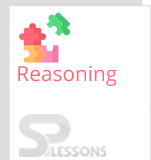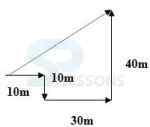 Introduction
Introduction
What is Reasoning Ability Test?
A logical reasoning test is a form of psychometric testing that is widely used by corporate employers to help assess candidates during their recruitment process. 'Psychometric' is just a fancy way of saying 'measuring mental ability' and logical reasoning tests are designed to measure your non-verbal skills.
The article IBPS RRB Reasoning Ability Quiz 9 provides Reasoning Ability questions with answers useful to the candidates preparing for Competitive exams, Entrance exams, Interviews etc. IBPS RRB has released IBPS RRB Officer 2019 Official Notification for Officer Scale(I, II, and II). Reasoning Ability plays major role to qualify examination. The article IBPS RRB Reasoning Ability Quiz 9 will assist the students understanding of the type of questions expected from the topic Reasoning Ability. IBPS RRB 2019 Office Assistant Preliminary Exam will be conducted on 17th, 18th & 25th August 2019 and the Mains Exam will be conducted on 29th September 2019.
 Quiz
Quiz
Direction(1-5): Study the following information carefully to answer the given questions.
There are eight persons namely A, B, C, D, E, F, G and H has born in the same month of different year i.e. 1969, 1972, 1978, 1981, 1989, 1997, 2000 and 2005. Their age are considered as on the same month of 2017. G is born in even number year, but not born in the year, which does not divisible by 4. A is 36 years old now. B is 17 year older than F, who is 8 years younger than A. There are eight years gap between age of E and age of D. H is nine year younger than C, but not born in 2005. E was born earlier than G.
1. Who amongst the following was born in 2000?
- A. E
B. A
C. B
D. G
E. F
- A. D – 1997
B. A – 1972
C. A – 1989
D. D – 2005
E. None of the given options is true
- A. hree
B. Four
C. Two
D. One
E. None of these
- A. Three
B. Two
C. Four
D. Five
E. None of these
- A. 1969
B. 1972
C. 1978
D. 1981
E. 1997
| Person | Year |
|---|---|
| C | 1969 |
| B | 1972 |
| H | 1978 |
| A | 1981 |
| F | 1989 |
| E | 1997 |
| G | 2000 |
| D | 2005 |
Direction(1-5): Study the following information carefully to answer the given questions.
Eight teachers A, B, C, D, E, F, G & H are sitting on a cement bench. Some are facing north and some are facing south. They all like different colors ; Green, yellow, blue, white, brown,pink , black and red.
- G is not an immediate neighbor of A.E sits fifth to the right of G
- A & D sitting at the extreme ends and no one sitting at the extreme ends like black or yellow.
- E doesn’t like white or black or green , and faces the direction opposite to that of H.
- B faces south. And none of the people who sit at the extreme ends face south.
- The one who likes pink is the immediate neighbor of two north facing teachers.There are four people between A & C
- None of the people who face north likes pink, or white or blue. H likes red.
- G sits third to the right of F and does not sit on any ends. There are as many people between E & H as there is to the right of C.
- A. Black
B. Green
C. Red
D. Yellow
E. Cannot be determined
- A. G
B. B
C. The one who likes green
D. The one who liked red
E. Cannot be answered
- A. A
B. B
C. C
D. G
E. A or D
- A. A
B. F
C. H
D. C
E. D
- A. Pink
B. Brown
C. Yellow
D. Black
E. Cannot be determined
1. Statement:
In communication, more should happen in less.
Assumptions:
I. The more you talk, the less you communicate.
II. The process of communication is never complete.
- A. If only assumption I is implicit.
B. If only assumption II is implicit.
C. If either I or II is implicit.
D. If neither I nor II is implicit.
E. If both I and II are implicit.
- A. E ≤ P
B. S < P
C. M > P
D. E < S
E. T ≤ M
- A. More than three
B. One
C. Two
D. Three
E. None of these
- A. North-west 30m
B. South-west 50m
C. North-east 50m
D. North-east 60m
E. None of these
- A. Mother
B. Father
C. Brother
D. Sister
E. None of these
Other Articles
 Study Guide
Study Guide
 Exams
Exams
| Competitive Exams - Entrance Exams | |||
|---|---|---|---|
| Category | Notification | ||
| UG | NSTSE 2020 | RIMC Admission 2020 | TS NTSE 2019 |
| Diploma | HPBOSE D.El.Ed CET 2019 | Goa Diploma Admissions 2019 | |
PG |
GATE 2020 |
ATMA 2019 |
XAT 2020 |
| Click Here For – All India Entrance Exam Notifications | |||
 Daily CA
Daily CA
 Job-Alerts
Job-Alerts
 SP Quiz
SP Quiz
| Competitive Exams - Practice Sets | |
|---|---|
| Category | Quiz |
| Reasoning Ability | Seating Arrangement |
| Quantitative Aptitude | Simple Interest |
| Compound Interest | |
 GK
GK
| General Knowledge for Competitive Examinations | |
|---|---|
| Topic | Name of the Article |
| GK - World | Multinational Companies CEOs |
| Global Innovation Index 2019 | |
| GK - India | Indus Valley Civilization |
| Educational Qualifications of Telangana MLAs 2019 | |
| GK - Abbreviations | Indian Government Policies Abbreviations |
| Sports Abbreviations | |
| GK - Banking & Insurance | Public Sector Banks – Headquarters and Taglines |
| Banks and Headquarters | |
| GK - Science & Technology | Human Body Facts |
| Web Portals | |
| Father of Different Fields – Science & Technology | |





